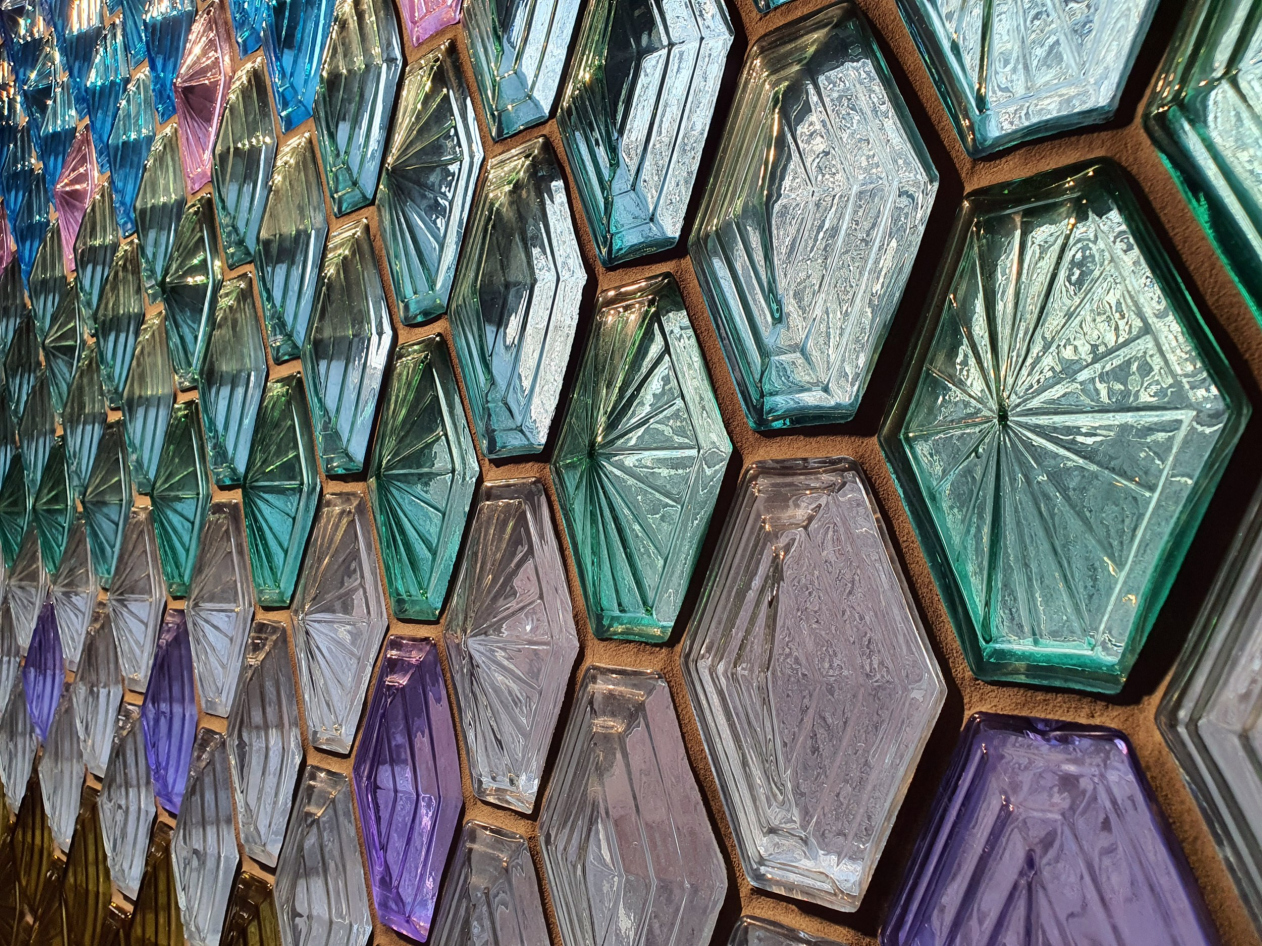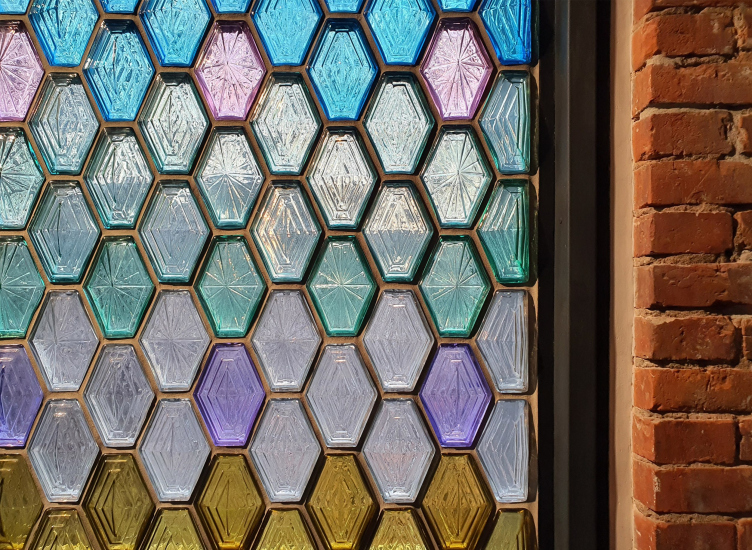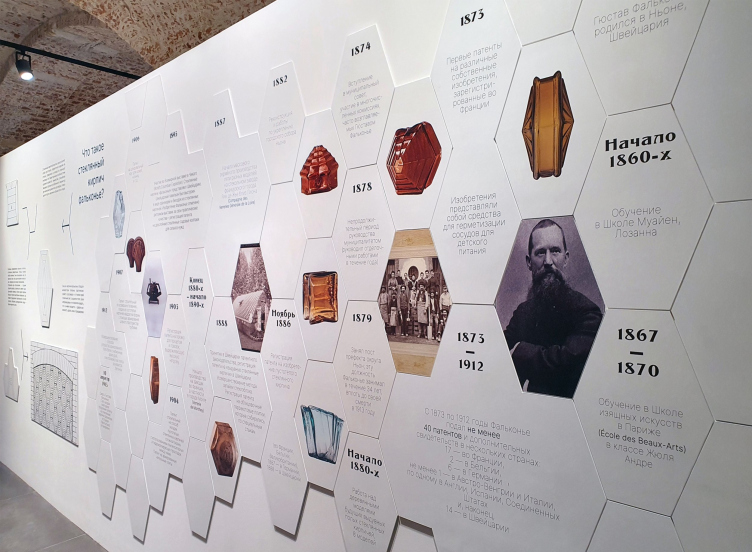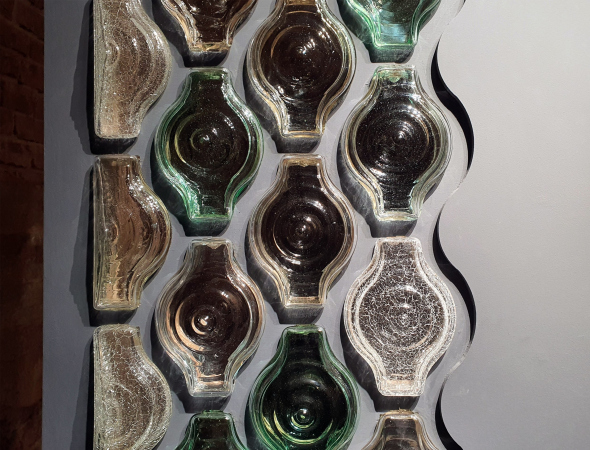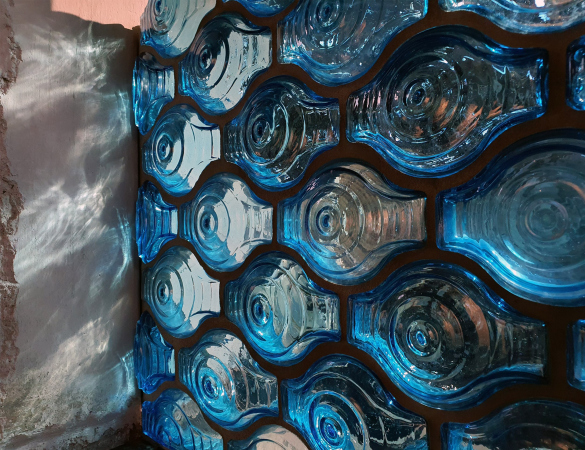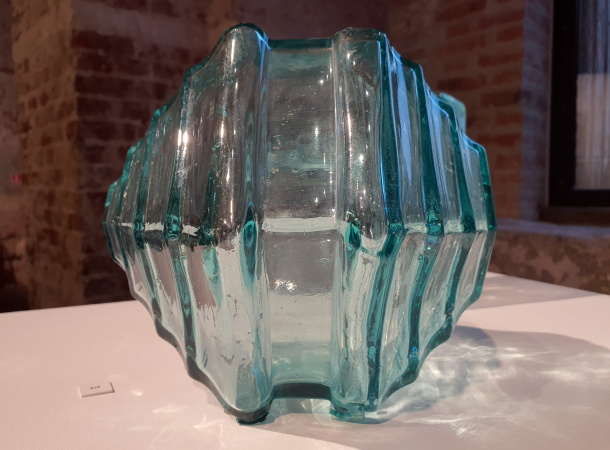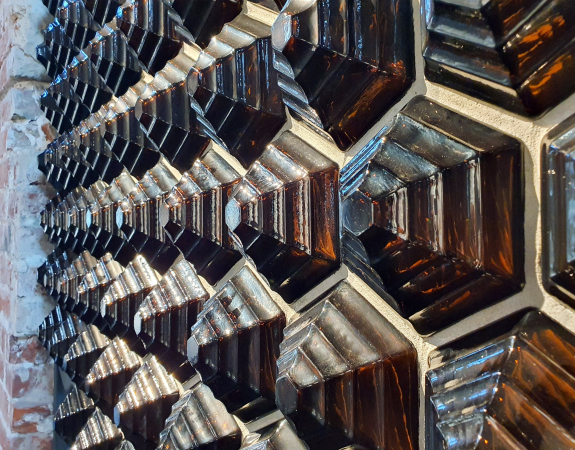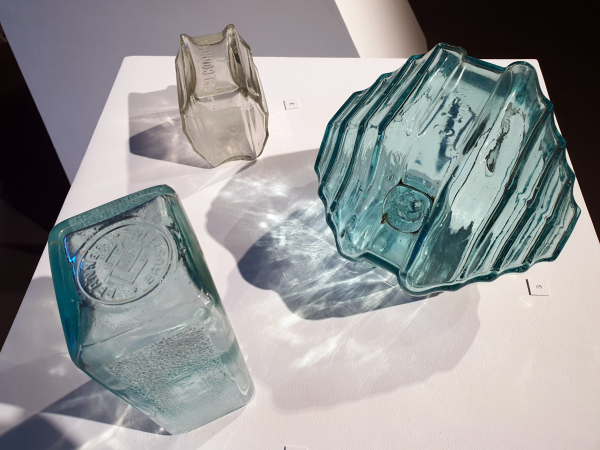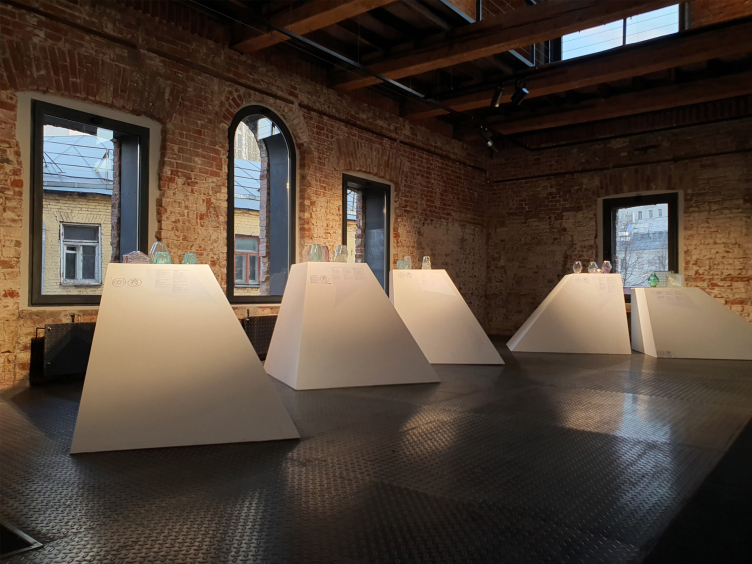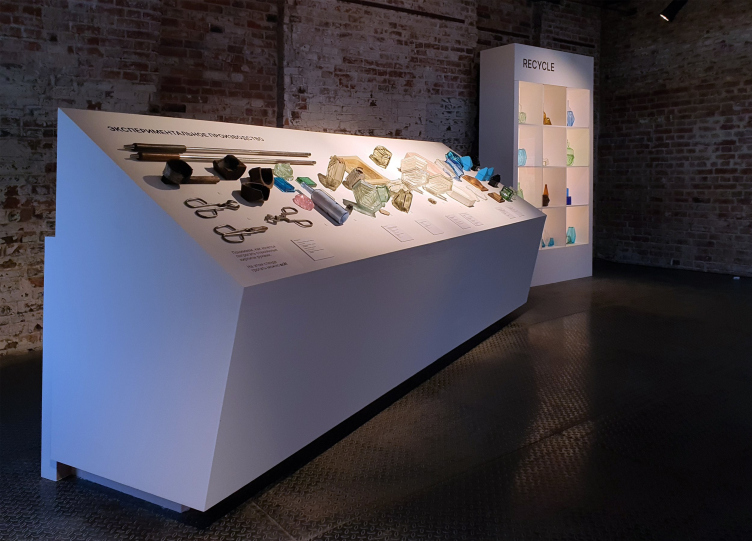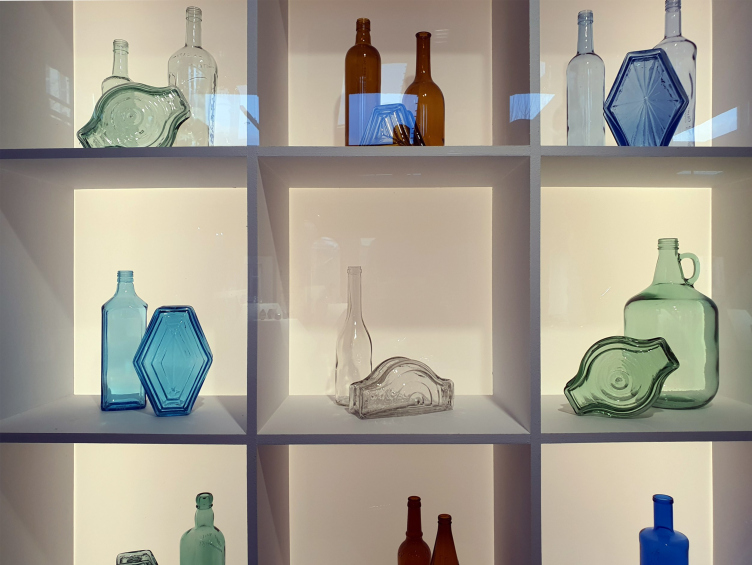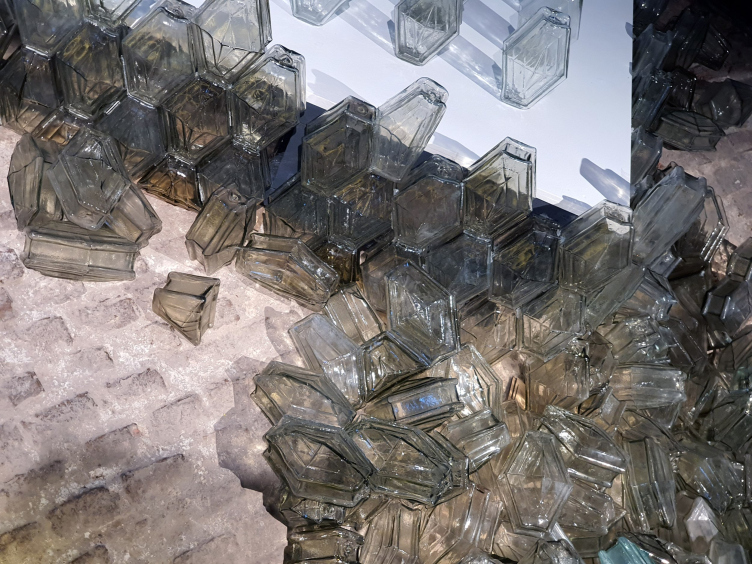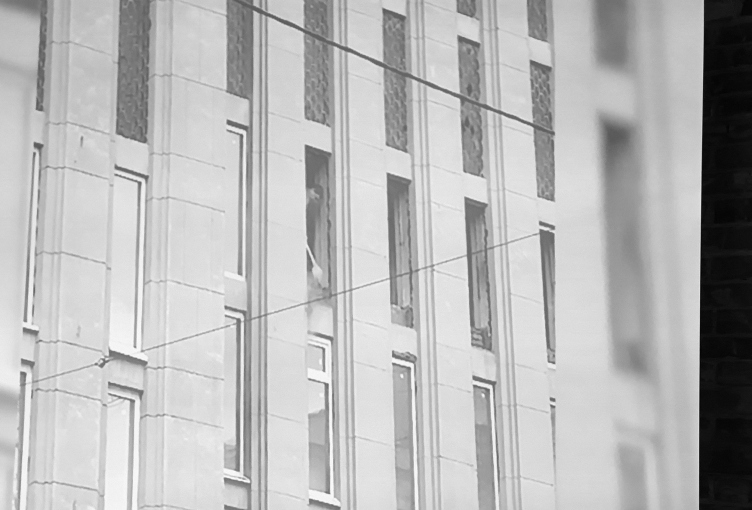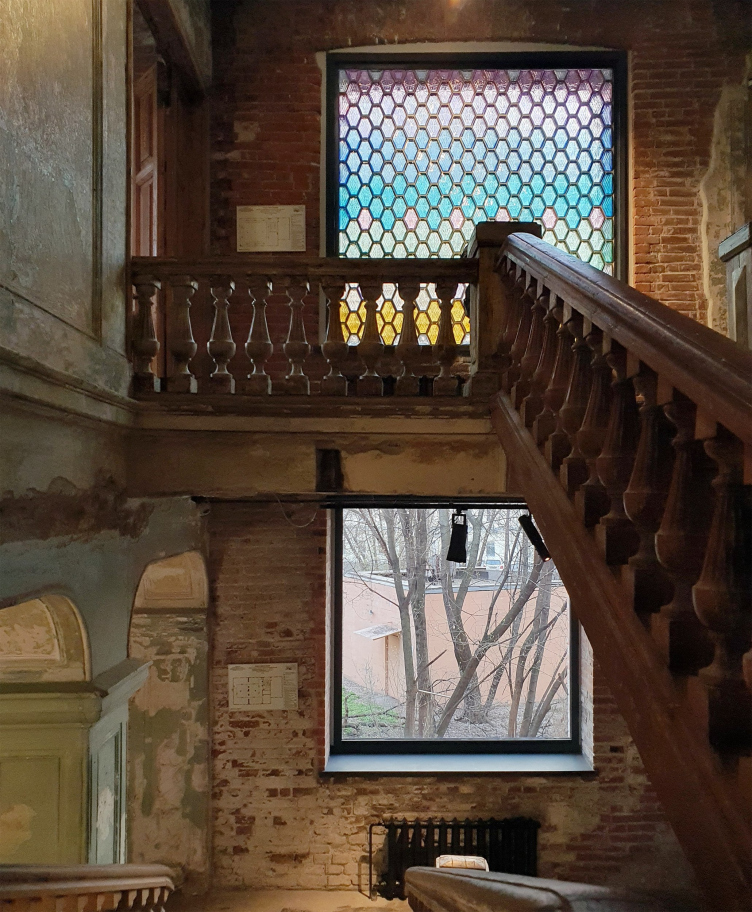"Falconnier. Architecture of Light" exhibition. Museum of Architecture, the “Ruin” wing, 07.04.2023 – 20.08.2023
Copyright: Photograph © Julia tarabarina / Archi.ru
"Falconnier. Architecture of Light" exhibition. Museum of Architecture, the “Ruin” wing, 07.04.2023 – 20.08.2023
Copyright: Photograph © Julia tarabarina / Archi.ru
In 1913, Gustave Falconnier died, and the patent was suspended. However, the bricks were still produced until around the 1930s, after which they were replaced by glass blocks that were more predictable, cheaper, did not require the glassblower’s lungs, and could be stamped into shape. Predictably, they were also more uniform, usually square.
"Falconnier. Architecture of Light" exhibition. Museum of Architecture, the “Ruin” wing, 07.04.2023 – 20.08.2023
Copyright: Photograph © Julia tarabarina / Archi.ru
The Falconnier glass bricks now come in 16 different types, with the most complex shape resembling a baluster or a chubby pitcher; one of the most common is the elongated hexagon, but there are also flattened hexagons with stepped “hills”; there are also simple squares. Plus color. Glass blocks are not often colored, but I have seen white, light-blue, and yellow ones. In the case of Falconnier’s bricks, however, there’s almost the entire spectrum presented: cobalt blue and light-blue, brown and yellow, and a multitude of pastel shades. Strangely, there is little or no red. Sometimes an artificial crackle is added to the shape and color, as shown on the entrance stand.
The benefit of Falconnier glass bricks was twofold. Before glass blocks became widespread, the Falconnier bricks were the only ones that allowed an opening to be covered without depriving the room of natural light, but without providing a window-to-window view. This was particularly useful for firewalls, where such proximity was prohibited by regulations, or to separate the rooms of the servants, which was also understandable and practical.
However, the bricks are very beautiful, and it would be surprising if their aesthetics were not appreciated. They allow for the creation of colorful stained-glass windows, which are absolutely luxurious, and even better, glass domes that are lightweight and quite large. In Moscow, one such dome remains in the building of the Indian embassy, which is located in the Bardygin estate of 1911 in the Vorontsovo Field Street. Glass domes and walls are, of course, already part of the architecture, a technology that dictates both the lighting and the volumetric/spatial solution. Sometimes, however, domes fell, since the load was not always correctly calculated, and the bricks were glued together with a special solution.
The meaning of the exhibition is also twofold. On the one hand, it is research based on previous studies and information obtained from the Falconnier glass collection, which was exhibited in Nyon in 2018, inspiring the current exhibition at the Museum of Architecture. At some point, the museum actively collaborated with Nyon, and they planned to bring part of the collection, but for objective reasons, it did not work out, which is why the current exhibition may seem a bit empty.
The feeling is enhanced by the pedestals offered by the exhibition designer Agnia Sterligova: they are white pyramids that widen significantly towards the bottom, as if slightly pushing the viewer away from the object. The reception was designed so as not to “cover the glass with glass” and at the same time somehow prevent viewers from touching the originals. Even though the objects are open, people still tend to reach out to touch them, making it even less stable. Therefore, I cannot say that the pyramid solution is very successful. But it is elegant, and overall, it seems that Agnia Sterligova has moved from bright, colorful, and “tell-tale” embellished exhibition designs to more concise solutions.
"Falconnier. Architecture of Light" exhibition. Museum of Architecture, the “Ruin” wing, 07.04.2023 – 20.08.2023
Copyright: Photograph © Julia tarabarina / Archi.ru
"Falconnier. Architecture of Light" exhibition. Museum of Architecture, the “Ruin” wing, 07.04.2023 – 20.08.2023
Copyright: Photograph © Julia tarabarina / Archi.ru
On the other hand, there is a stand where “you can touch everything” – you just have to endure until you reach the second floor, where there is a showcase dedicated to the revival of the Falconnier technology. There is a blowing pipe, scissors for cutting, and models of forms, including those printed from historical samples for analysis.
The revival of technology is the second, and perhaps even the primary, meaning and feature of the exhibition, after exploration, as it has become a “driver” for the restoration of production. Here’s the story: Nikita Andreev, an art historian, a graduate of the Stieglitz Academy, and a roofer, found a window in the Bashevich house in St. Petersburg that was filled with glass bricks. He took a “couple of fallen samples” and became interested in studying the subject. In 2018, he learned about the Falconnier exhibition in Nyon, shared the information with the Museum of Architecture, and its director, Elizaveta Likhacheva, invited Nikita Andreev to curate an exhibition dedicated to Falconnier bricks at the museum. For the exhibition (!), the revival of brick production was organized – Ivan Kozitsyn, a teacher at the Stieglitz Academy and the NWGlass.lab workshop, took on this task. Now, the workshop produces restoration-quality bricks, and their use has already been applied in restoring windows in the Eroshenko house in St. Petersburg and the Shelukhin house in Nizhny Novgorod. But the biggest order at the moment was from the museum for the exhibition: variously shaped and colored bricks were used to create several openings on the 1st and 2nd floors, and a lilac-and-pink window on the 3rd floor on the stairs – the latter is likely to be preserved. The exhibition shows videos of the brick-blowing process, defective samples, and molds, including those that were part of the technology development process.
"Falconnier. Architecture of Light" exhibition. Museum of Architecture, the “Ruin” wing, 07.04.2023 – 20.08.2023
Copyright: Photograph © Julia tarabarina / Archi.ru
"Falconnier. Architecture of Light" exhibition. Museum of Architecture, the “Ruin” wing, 07.04.2023 – 20.08.2023
Copyright: Photograph © Julia tarabarina / Archi.ru
The bricks are currently blown from recycled glass bottles, selecting bottles by color – the museum staff and curators collected these bottles from bars. In other words, the exhibition shows a living process, and it even became a part of it. A hundred years ago, Falconnier showed a pavilion made of glass bricks in Chicago, and they became popular. In that case, maybe it could happen again now, at least for restoration purposes. However, the bricks are already sold as souvenirs, both in the museum shop and online.
"Falconnier. Architecture of Light" exhibition. Museum of Architecture, the “Ruin” wing, 07.04.2023 – 20.08.2023
Copyright: Photograph © Julia tarabarina / Archi.ru
There is another part of the living process, and that is destruction. In 2018, a Falconnier exhibition was held in Nyon, and at the end of 2019 in Moscow, despite protests by the local preservation activists, all the glass brick windows in the building of the State Archives on Bolshaya Pirogovskaya Street were smashed and replaced with double-glazed windows. Employees of the Museum of Architecture saved some of the bricks from the archive building – the story is described here by the second curator of the Moscow Falconnier exhibition, Anna Kistanova. Some of the “bricks” were taken into storage by the museum, while others are simply kept – they make up an installation at the exhibition accompanied by a video recording of a builder hitting bricks with a hammer.
"Falconnier. Architecture of Light" exhibition. Museum of Architecture, the “Ruin” wing, 07.04.2023 – 20.08.2023
Copyright: Photograph © Julia tarabarina / Archi.ru
"Falconnier. Architecture of Light" exhibition. Museum of Architecture, the “Ruin” wing, 07.04.2023 – 20.08.2023
Copyright: Photograph © Julia tarabarina / Archi.ru
In short, it is a rather curious slice of life from birth to death and back to revival again: here things are broken, and rebuilt.
The technology is quite precise and intricate, not designed for large volumes and pragmatic use – but they say that now it’s possible to make 20-25 Falconnier bricks in a day – provided, you have enough bottles, of course.
"Falconnier. Architecture of Light" exhibition. Museum of Architecture, the “Ruin” wing, 07.04.2023 – 20.08.2023
Copyright: Photograph © Julia tarabarina / Archi.ru

